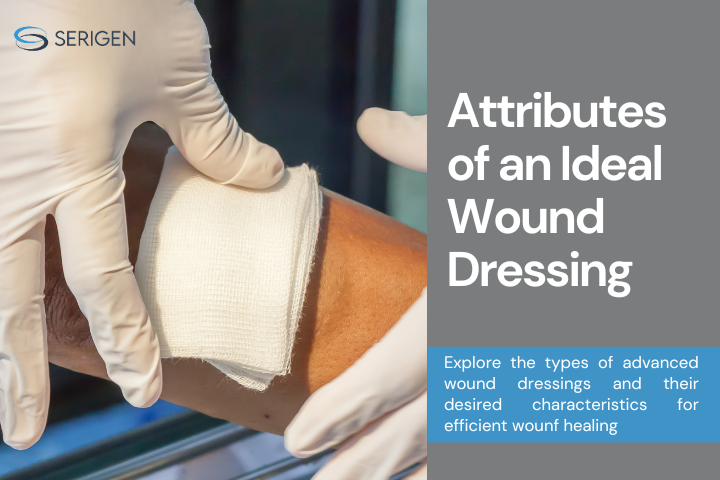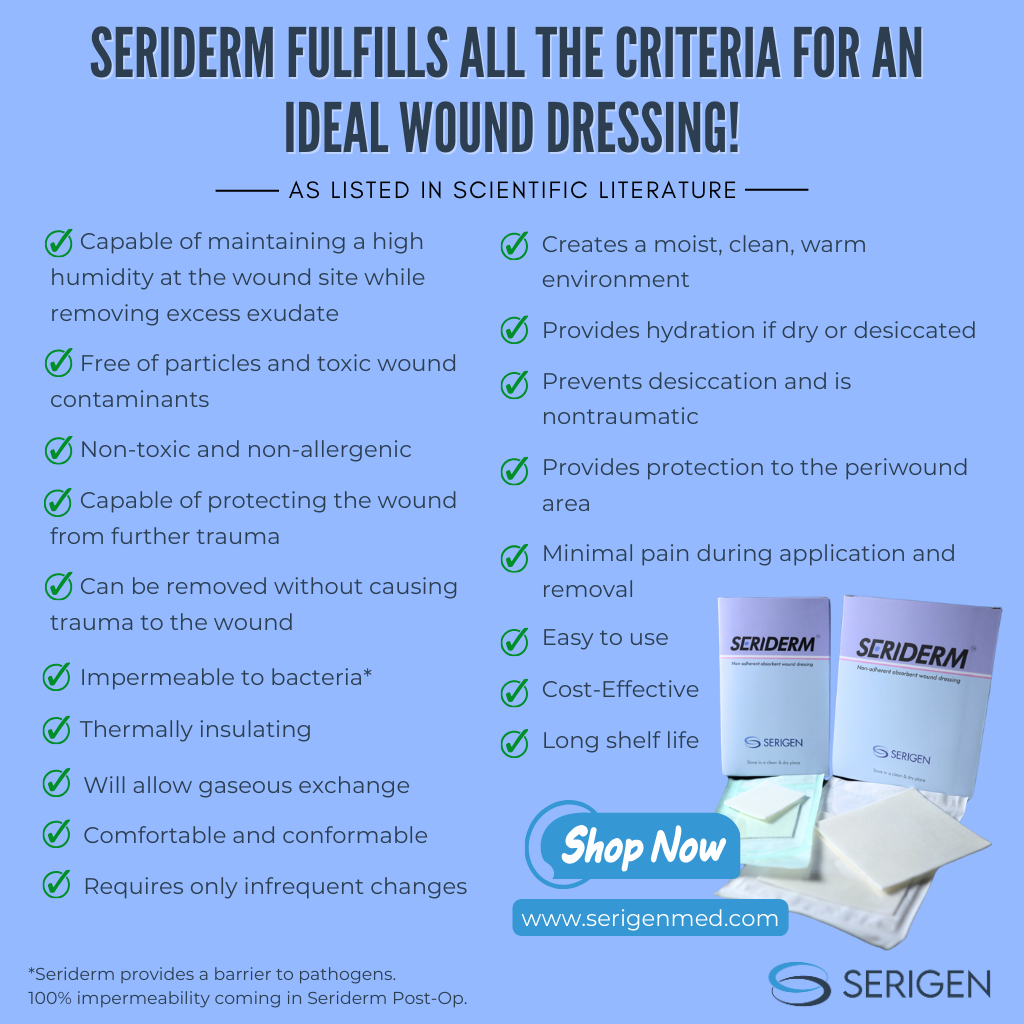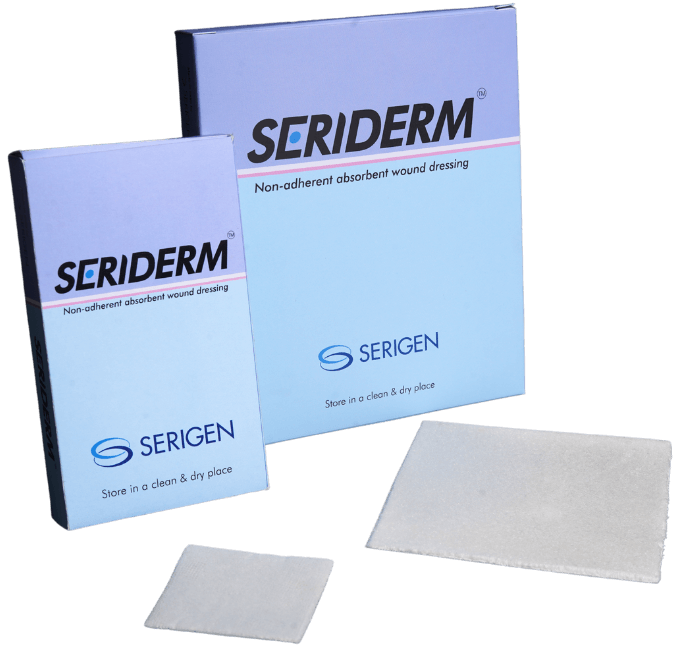Types of Wound Dressings and Desired Attributes for Optimal Wound Healing

Wound care is a critical component of medical treatment, requiring precision and the right materials to promote wound healing and prevent complications. Wound dressings are a crucial part of wound care, essential for promoting healing, preventing infection, and protecting the wound site.
The ideal wound dressing must meet several key criteria, ensuring optimal conditions for the wound to heal effectively. In this blog post, we explore the different types of advanced wound dressings and identify essential characteristics of an ideal wound dressing, drawing on insights from authoritative sources.
Types of Advanced Wound Dressings
Advanced wound dressings are designed to create optimal conditions for wound healing by maintaining a moist environment, protecting the wound from infection, and promoting tissue regeneration. Here are some types of advanced wound dressings:
1. Hydrocolloid Dressings
- Description: Composed of gelatin, pectin, and carboxymethylcellulose, these dressings form a gel when in contact with wound exudate.
- Benefits: They provide a moist environment, promote autolytic debridement, and are impermeable to bacteria and contaminants.
2. Hydrogel Dressings
- Description: Made of water or glycerin-based gels, these dressings help hydrate the wound bed.
- Benefits: They provide moisture to dry wounds, promote autolytic debridement, and can be soothing and reduce pain.
3. Foam Dressings
- Description: These dressings are made of polyurethane foam and are designed to absorb exudate.
- Benefits: They offer good absorption, cushioning, and protection, maintaining a moist wound environment.
4. Alginate Dressings
- Description: Derived from seaweed, these dressings form a gel when in contact with wound exudate.
- Benefits: Highly absorbent, they promote autolytic debridement and maintain a moist wound environment.
5. Collagen Dressings
- Description: Made from animal sources like bovine or porcine collagen.
- Benefits: They promote new tissue growth, support wound healing, and help maintain a moist environment.
6. Antimicrobial Dressings
- Description: Infused with agents like silver or iodine to reduce bacterial load.
- Benefits: They help prevent or treat infection and maintain a moist wound environment.
7. Transparent Film Dressings
- Description: Thin, flexible dressings made of transparent polyurethane.
- Benefits: They provide a moist environment, are waterproof, and allow for wound monitoring without removal.
8. Composite Dressings
- Description: Multi-layer dressings that combine different types of materials to address multiple wound needs.
- Benefits: They offer absorption, bacterial barrier protection, and a moist healing environment.
9. Silicone Dressings
- Description: Made with a soft silicone layer that adheres gently to the skin.
- Benefits: They minimize trauma and pain during dressing changes, protect the wound, and maintain a moist environment.
10. Seriderm – Non-Adherent, Absorbent Silk-Based Dressing
- Description: Seriderm is a non-adherent and absorbent wound dressing with the healing benefits of 98% silk protein.
- Benefits: Seriderm accelerates wound healing by offering a moist environment and visible improvement in inflammatory markers. The dressing is non-adherent and absorbent to minimize discomfort during dressing changes and to ensure optimal moisture management at the wound site. Furthermore, Seriderm’s novel composition contains silk proteins, which modulate cellular pathways resulting in better vasculature and granulation tissue formation for expedited wound healing. Therefore, Seriderm combines the advantages of different types of advanced wound dressings to ensure efficient healing of complex chronic and acute wounds.
Characteristics of an Ideal Wound Dressing: According to Scientific Literature
Scientific literature lists the characteristics of an ideal wound dressing based on the optimal wound-healing environment required for efficient healing. According to an excerpt from the book ABC of Wound Healing by the British Medical Journal, an ideal wound dressing must exhibit the following characteristics:
- Capable of maintaining a high humidity at the wound site while removing excess exudate
- Free of particles and toxic wound contaminants
- Non-toxic and non-allergenic
- Capable of protecting the wound from further trauma
- Can be removed without causing trauma to the wound
- Impermeable to bacteria*
- Thermally insulating
- Will allow gaseous exchange
- Comfortable and conformable
- Require only infrequent changes
- Cost-effective
- Long shelf life
Similarly, an article from the Advances In Wound Care Journal states the following as the characteristics of an ideal wound dressing:
- Creates a moist, clean, warm environment
- Provides hydration if dry or desiccated
- Removes excess exudates
- Prevents desiccation and is nontraumatic
- Provides protection to the periwound area
- Allows for gaseous exchange
- Impermeable to microorganisms*
- Free of toxic or irritant particles
- Does not release particles or fibers
- Can conform to wound shape
- Minimal pain during application and removal
- Easy to use
- Cost-effective
Seriderm is a cutting-edge silk-based wound dressing that fulfills all the characteristics of an ideal wound dressing listed in the cited publications*. With its ideal properties, Seriderm has demonstrated superior wound healing of a wide range of wounds in clinical use cases, including diabetic ulcers, surgical wounds, deep trauma wounds, venous graft site wounds and burns.

Additionally, Seriderm Ag combines the healing power of Seriderm with the antimicrobial action of silver ions, making it the ideal wound dressing for infected or high-risk wounds. Therefore, Serigen’s portfolio of wound dressings caters to a wide range of wounds and meets the optimal criteria for efficient wound care. Hence, the use of Seriderm for treating difficult-to-heal wounds can lead to a significant improvement in treatment outcomes!
Note – *Seriderm provides a barrier to pathogens. 100% impermeability coming in Seriderm Post-Op.
References
- https://www.ncbi.nlm.nih.gov/pmc/articles/PMC4121107/
- https://www.wiley.com/en-au/ABC+of+Wound+Healing%2C+2nd+Edition-p-9780470658970

Author Bio – Dr. Premnath Venugopalan is Co-founder and Chair at Serigen Mediproducts. He holds a PhD from MIT USA and is a trained chemical engineer from IIT-Bombay (Distinguished Alumnus, 2022), along with being a Chevening Technology Enterprise Scholar in Cambridge, UK. He is also Head, NCL Innovations at CSIR-NCL and Founder Director at Venture Center.

Wound care is a critical component of medical treatment, requiring precision and the right materials to promote wound healing and prevent complications. Wound dressings are a crucial part of wound care, essential for promoting healing, preventing infection, and protecting the wound site.
The ideal wound dressing must meet several key criteria, ensuring optimal conditions for the wound to heal effectively. In this blog post, we explore the different types of advanced wound dressings and identify essential characteristics of an ideal wound dressing, drawing on insights from authoritative sources.
Types of Advanced Wound Dressings
Advanced wound dressings are designed to create optimal conditions for wound healing by maintaining a moist environment, protecting the wound from infection, and promoting tissue regeneration. Here are some types of advanced wound dressings:
1. Hydrocolloid Dressings
- Description: Composed of gelatin, pectin, and carboxymethylcellulose, these dressings form a gel when in contact with wound exudate.
- Benefits: They provide a moist environment, promote autolytic debridement, and are impermeable to bacteria and contaminants.
2. Hydrogel Dressings
- Description: Made of water or glycerin-based gels, these dressings help hydrate the wound bed.
- Benefits: They provide moisture to dry wounds, promote autolytic debridement, and can be soothing and reduce pain.
3. Foam Dressings
- Description: These dressings are made of polyurethane foam and are designed to absorb exudate.
- Benefits: They offer good absorption, cushioning, and protection, maintaining a moist wound environment.
4. Alginate Dressings
- Description: Derived from seaweed, these dressings form a gel when in contact with wound exudate.
- Benefits: Highly absorbent, they promote autolytic debridement and maintain a moist wound environment.
5. Collagen Dressings
- Description: Made from animal sources like bovine or porcine collagen.
- Benefits: They promote new tissue growth, support wound healing, and help maintain a moist environment.
6. Antimicrobial Dressings
- Description: Infused with agents like silver or iodine to reduce bacterial load.
- Benefits: They help prevent or treat infection and maintain a moist wound environment.
7. Transparent Film Dressings
- Description: Thin, flexible dressings made of transparent polyurethane.
- Benefits: They provide a moist environment, are waterproof, and allow for wound monitoring without removal.
8. Composite Dressings
- Description: Multi-layer dressings that combine different types of materials to address multiple wound needs.
- Benefits: They offer absorption, bacterial barrier protection, and a moist healing environment.
9. Silicone Dressings
- Description: Made with a soft silicone layer that adheres gently to the skin.
- Benefits: They minimize trauma and pain during dressing changes, protect the wound, and maintain a moist environment.
10. Seriderm – Non-Adherent, Absorbent Silk-Based Dressing
- Description: Seriderm is a non-adherent and absorbent wound dressing with the healing benefits of 98% silk protein.
- Benefits: Seriderm accelerates wound healing by offering a moist environment and visible improvement in inflammatory markers. The dressing is non-adherent and absorbent to minimize discomfort during dressing changes and to ensure optimal moisture management at the wound site. Furthermore, Seriderm’s novel composition contains silk proteins, which modulate cellular pathways resulting in better vasculature and granulation tissue formation for expedited wound healing. Therefore, Seriderm combines the advantages of different types of advanced wound dressings to ensure efficient healing of complex chronic and acute wounds.
Characteristics of an Ideal Wound Dressing: According to Scientific Literature
Scientific literature lists the characteristics of an ideal wound dressing based on the optimal wound-healing environment required for efficient healing. According to an excerpt from the book ABC of Wound Healing by the British Medical Journal, an ideal wound dressing must exhibit the following characteristics:
- Capable of maintaining a high humidity at the wound site while removing excess exudate
- Free of particles and toxic wound contaminants
- Non-toxic and non-allergenic
- Capable of protecting the wound from further trauma
- Can be removed without causing trauma to the wound
- Impermeable to bacteria*
- Thermally insulating
- Will allow gaseous exchange
- Comfortable and conformable
- Require only infrequent changes
- Cost-effective
- Long shelf life
Similarly, an article from the Advances In Wound Care Journal states the following as the characteristics of an ideal wound dressing:
- Creates a moist, clean, warm environment
- Provides hydration if dry or desiccated
- Removes excess exudates
- Prevents desiccation and is nontraumatic
- Provides protection to the periwound area
- Allows for gaseous exchange
- Impermeable to microorganisms*
- Free of toxic or irritant particles
- Does not release particles or fibers
- Can conform to wound shape
- Minimal pain during application and removal
- Easy to use
- Cost-effective
Seriderm is a cutting-edge silk-based wound dressing that fulfills all the characteristics of an ideal wound dressing listed in the cited publications*. With its ideal properties, Seriderm has demonstrated superior wound healing of a wide range of wounds in clinical use cases, including diabetic ulcers, surgical wounds, deep trauma wounds, venous graft site wounds and burns.

Additionally, Seriderm Ag combines the healing power of Seriderm with the antimicrobial action of silver ions, making it the ideal wound dressing for infected or high-risk wounds. Therefore, Serigen’s portfolio of wound dressings caters to a wide range of wounds and meets the optimal criteria for efficient wound care. Hence, the use of Seriderm for treating difficult-to-heal wounds can lead to a significant improvement in treatment outcomes!
Note – *Seriderm provides a barrier to pathogens. 100% impermeability coming in Seriderm Post-Op.
References
- https://www.ncbi.nlm.nih.gov/pmc/articles/PMC4121107/
- https://www.wiley.com/en-au/ABC+of+Wound+Healing%2C+2nd+Edition-p-9780470658970

Author Bio – Dr. Premnath Venugopalan is Co-founder and Chair at Serigen Mediproducts. He holds a PhD from MIT USA and is a trained chemical engineer from IIT-Bombay (Distinguished Alumnus, 2022), along with being a Chevening Technology Enterprise Scholar in Cambridge, UK. He is also Head, NCL Innovations at CSIR-NCL and Founder Director at Venture Center.












